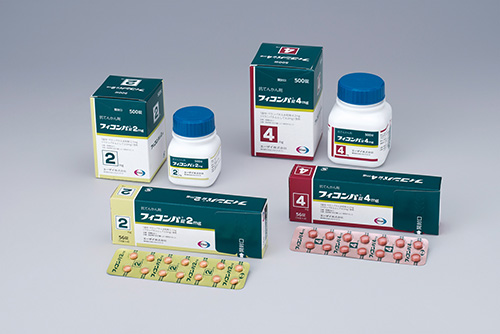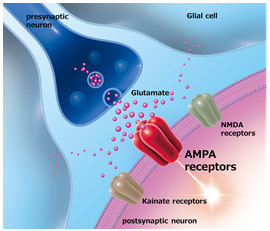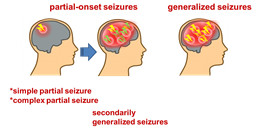- For Print
- May 25, 2016
Eisai Co., Ltd. (Headquarters: Tokyo, CEO: Haruo Naito, “Eisai”) announced today that it will launch its in-house-discovered antiepileptic drug (AED) Fycompa® Tablets 2 mg and 4 mg (perampanel hydrate) as an adjunctive therapy for partial-onset seizures (including secondarily generalized seizures) or primary generalized tonic-clonic seizures in patients with epilepsy showing inadequate response to other AEDs in Japan on May 26, 2016. Eisai received marketing and manufacturing approval for this formulation on March 28, 2016, and the product has been added to Japan's National Health Insurance drug price list as of today.
Discovered at Eisai's Tsukuba Research Laboratories and developed in-house, Fycompa is a first-in-class AED, available in tablet form as a once-daily oral dose. It is a highly selective, noncompetitive AMPA receptor antagonist that reduces neuronal hyperexcitation associated with seizures by targeting glutamate activity at postsynaptic AMPA receptors. In both a Phase Ⅲ clinical study (Study 335)1 of adjunctive Fycompa in refractory partial-onset seizures, as well as a Phase Ⅲ clinical study (Study 332)2 of adjunctive Fycompa in primary generalized tonic-clonic (PGTC) seizures, Fycompa demonstrated a statistically significant reduction in seizure frequency. Furthermore, in Study 332, 30.9% of patients treated with Fycompa were free of PGTC seizures during the 13 week maintenance period (12.3% for placebo). The most common adverse events (≥10% in the perampanel arms and greater than placebo) observed in Studies 332 and 335 were dizziness, fatigue, headache, somnolence and irritability.
Epilepsy affects approximately 1 million people in Japan. Epilepsy is broadly categorized by seizure type, with partial-onset seizures accounting for approximately 60% of epilepsy cases and generalized seizures accounting for approximately 40%. PGTC seizures are one of the most common and most severe forms of generalized seizures, accounting for approximately 60% of generalized seizures and approximately 20% of all epilepsy cases.3 The frequency of generalized tonic-clonic seizures is the most important risk factor associated with sudden unexpected death in epilepsy (SUDEP).4 As approximately 30% of patients with epilepsy are unable to control their seizures with currently available AEDs,5 this is a disease with significant unmet medical needs.
Fycompa is currently approved in more than 45 countries and territories, including Europe and the United States, as an adjunctive treatment of partial-onset seizures (with or without secondarily generalized seizures) in adult and adolescent patients with epilepsy 12 years of age and older. Fycompa has been also been approved in more than 35 countries, including Europe and the United States, for the adjunctive therapy of PGTC seizures in patients with epilepsy 12 years of age and older.
Eisai considers neurology a therapeutic area of focus, and by providing Fycompa as a new treatment option in Japan in addition to the AEDs Inovelon® and Fostoin® as part of an extensive epilepsy product portfolio, Eisai seeks to make continued contributions to address the diverse needs of, as well as increasing the benefits provided to, patients with epilepsy and their families.
Media Inquiries:
Public Relations Department,
Eisai Co., Ltd.
+81-(0)3-3817-5120
< Notes to editors >
1. Product Outline
- 1)
Product name
Fycompa® Tablets 2 mg, Fycompa® Tablets 4 mg - 2)
Generic name
Perampanel hydrate - 3)
Indication for use
Adjunctive therapy for the types of seizures below in patients with epilepsy showing inadequate response to other antiepileptic drugs (AEDs)Partial-onset seizures (including secondarily generalized seizures)
Primary generalized tonic-clonic seizures
- 4)
Dosage and administration
The usual dose for adults and children 12 years of age or older is initially 2 mg once daily as perampanel at bedtime, and the daily dose may then be increased by 2 mg at intervals of 1 week or longer.
The maintenance dose is 8 mg once daily in the absence of concomitant AEDs that accelerate the metabolism of this product, or 8-12 mg once daily in the presence of such concomitant drugs.
Dosage may be increased or decreased as necessary by 2 mg at intervals of 1 week or longer depending on symptoms, but the maximum daily dose should not be over 12 mg. - 5)
Listed price
Fycompa Tablets 2 mg 189.70 yen per tablet
Fycompa Tablets 4 mg 310.20 yen per tablet - 6)
Packaging
Fycompa Tablets 2 mg 56 tablets (14 tablet PTP sheet x 4), 500 tablets (bottle)
Fycompa Tablets 4 mg 56 tablets (14 tablet PTP sheet x 4), 500 tablets (bottle) - 7)
Product photograph

2. About Fycompa
Fycompa is a first-in-class AED discovered and developed by Eisai. With epileptic seizures being mediated by the neurotransmitter glutamate, the agent is a highly selective, noncompetitive AMPA receptor antagonist that reduces neuronal hyperexcitation associated with seizures by targeting glutamate activity at postsynaptic AMPA receptors. Fycompa is available in tablet form as a once-daily oral dose.
The agent is currently approved in more than 45 countries and territories, including Europe and the United States, as an adjunctive treatment of partial-onset seizures (with or without secondarily generalized seizures) in adult and adolescent patients with epilepsy 12 years of age and older.
In addition, Fycompa has been approved in more than 35 countries, including Europe and the United States for the adjunctive therapy of primary generalized tonic-clonic (PGTC) seizures in patients with epilepsy 12 years of age and older. More specifically, Eisai has obtained approval for the agent indicated in the United States as an adjunctive treatment of PGTC seizures in patients with epilepsy 12 years of age and older, and in Europe as an adjunctive treatment of PGTC seizures in adult and adolescent patients from 12 years of age with idiopathic generalized epilepsy.
Fycompa is approved in Japan indicated as an adjunctive therapy for partial-onset seizures (including secondarily generalized seizures) or primary generalized tonic-clonic seizures in patients with epilepsy showing inadequate response to other AEDs.
Furthermore, Eisai submitted applications for the approval of an additional oral suspension formulation of perampanel in Europe and the United States in June 2015, and the application in the United States was approved in April 2016. In addition, Eisai is conducting Phase Ⅱ studies in Europe and the United States for partial-onset epilepsy in pediatric patients.
3. About Study 3351
*You can scroll to the left or right here
| Study title: | A Multicenter, Double-blind, Randomized, Placebo-controlled, Parallel-group Study to Evaluate the Efficacy and Safety of Perampanel Administered as an Adjunctive Therapy in Subjects with Refractory Partial-onset Seizures |
| Study population: | 710 patients aged 12 years and older who have a diagnosis of epilepsy with partial-onset seizures with or without secondarily generalized seizures receiving one to a maximum of three anti-epileptic drugs |
| Treatment administered: | Perampanel oral tablets, 4 mg/day, 8 mg/day and 12 mg/day, once daily before bedtime Perampanel-matched placebo oral tablets, once daily before bedtime |
| Duration of treatment: | Prerandomization Phase: 6 weeks Randomization Phase (treatment): 19 weeks (Titration Period, 6 weeks; Maintenance Period, 13 weeks) Extension Phase: over 10 weeks |
| Study locations: | Japan, China, South Korea, Australia, Thailand, Malaysia, Taiwan |
| Primary endpoint: | Percent change in seizure frequency per 28 days during treatment relative to baseline |
| Results: | The percent change in seizure frequency in the placebo group was -10.8% while in the perampanel (4 mg, 8 mg, 12 mg) groups it was -17.3%, -29.0% and -38.0%, respectively. The difference between perampanel and placebo was statistically significant for the perampanel 8 and 12 mg groups (p=0.0003 for 8 mg, p<0.0001 for 12 mg). |
| Adverse events: | The most common adverse events (≥10% in the perampanel arms and greater than placebo) were dizziness (22.7%, 28.6%, 42.2% in the perampanel 4 mg, 8 mg, 12 mg groups respectively and 5.7% for placebo) and somnolence (15.9%, 17.7%, 17.8% in the perampanel 4 mg, 8 mg, 12 mg groups respectively and 13.1% for placebo). |
4. About Study 3322
*You can scroll to the left or right here
| Study title: | A Multicenter, Double-blind, Randomized, Placebo-controlled, Parallel-group Study to Evaluate the Efficacy and Safety of Adjunctive Perampanel in Refractory PGTC Seizures |
| Study population: | 164 patients aged 12 years and older with PGTC seizures receiving one to a maximum of three anti-epileptic drugs |
| Treatment administered: | (Placebo-controlled) Perampanel oral tablets, once daily, up to 8 mg/day (Titration Period), randomized dose 8 mg/day (Maintenance Period) |
| Duration of treatment: | Prerandomization Phase (Screening and Baseline Periods): up to 12 weeks Randomization Phase (treatment): 17 weeks (Titration Period, 4 weeks; Maintenance Period, 13 weeks) Extension Phase: over 38 weeks |
| Study locations: | U.S., Europe, Japan, Asia |
| Primary endpoint: | Percent change in PGTC seizure frequency (percent change from baseline in PGTC seizure frequency per 28 days during treatment) |
| Results: | -A change in PGTC seizure frequency of -76.5% was observed for perampanel, which was statistically significant when compared to a change of -38.4% for placebo (p<0.0001). -The responder rate for perampanel was 64.2%, which was a statistically significant improvement over the responder rate (percentage of patients who experience a 50% or greater reduction in PGTC seizure frequency per 28 days in the Maintenance period relative to baseline) for placebo of 39.5% (p=0.0019). -For patients who had been unable to adequately control PGTC seizures with existing AEDs, 30.9% of patients treated with perampanel were free of PGTC seizures (12.3% for placebo) during the 13 week Maintenance period. |
| Adverse events: | The most common adverse events (≥10% in the perampanel arm and greater than placebo) for perampanel and placebo were, respectively, dizziness (32.1% vs 6.1%), fatigue (14.8% vs 6.1%), headache (12.3% vs 9.8%), somnolence (11.1% vs 3.7%) and irritability (11.1% vs 2.4%). |
5. About AMPA Receptors
Neurons transmit information via synapses. When an electric signal is transmitted to a neuron, neurotransmitters are secreted to the synaptic cleft from vesicles on synapses. When neurotransmitters bind with receptors located on the cellular membrane of the next neuron, an electrical signal is generated and information is transmitted.
Glutamate is an excitatory neurotransmitter widely used throughout the central nervous system. There are various types of glutamate receptors including AMPA receptors, NMDA receptors and kainate receptors. Expressed in most central nerve cells, AMPA receptors mediate extremely fast synaptic transmission, and are thought to play a central role in the incidence and transmission of epileptic seizures.

6. About Epilepsy
Epilepsy affects approximately 1 million people in Japan, 2.9 million people in the United States, 6 million people in Europe, and approximately 60 million people worldwide. As approximately 30% of patients with epilepsy are unable to control their seizures with currently available AEDs,5 this is a disease with significant unmet medical needs.
Epilepsy is broadly categorized by seizure type, with partial-onset seizures accounting for approximately 60% of epilepsy cases and generalized seizures accounting for approximately 40%. In a partial-onset seizure, an abnormal electrical disturbance occurs in a limited area of the brain, and sometimes may subsequently spread throughout the brain, becoming a generalized seizure (known as a secondarily generalized seizure). In a generalized seizure, abnormal electrical disturbances occur throughout the brain, and can be followed by a loss of consciousness or physical symptoms manifested throughout the whole body.
Accounting for approximately 60% of generalized epilepsy and approximately 20% of all epilepsy cases,3 generalized tonic-clonic seizures are one of the most common and most severe forms of epileptic seizures as they can cause significant injury to patients from falling down suddenly, and the frequency of these seizures is the most important risk factor associated with sudden unexpected death in epilepsy (SUDEP).4
For the majority of patients, a generalized tonic-clonic seizure begins with a loss of consciousness without any prior warning symptoms and a sudden contraction of the tonic muscles, causing the patient to fall down (tonic phase). This is followed by violent convulsions (clonic phase) until the muscles finally relax, and the patient is left with a disturbance of consciousness. As this is a serious event, it is seen as a major hindrance on daily life. While the seizure generally only lasts a few minutes, the patient will often feel confused, groggy or drowsy for a short period of time before returning to normal.

- 1
Nishida T, et al. “A randomized double-blind, placebo-controlled study to evaluate the efficacy and safety of perampanel as adjunctive therapy in patients with refractory partial-onset seizures from the Asia-Pacific region.” Abstract. 69th American Epilepsy Society (AES) Annual Meeting, 2015; 3.256
- 2
French JA, et al. “Perampanel for tonic-clonic seizures in idiopathic generalized epilepsy.” Neurology 2015; 85, 950-957
- 3
Hauser WA, et al. Epilepsia, 34(3):453-468,1993
- 4
Shorvon S, Tomson T. “Sudden unexpected death in epilepsy.” Lancet, 2011; 378:2028-2038
- 5
“The Epilepsies and Seizures: Hope Through Research. What are the epilepsies?” National Institute of Neurological Disorders and Stroke, accessed May 24, 2016, http://www.ninds.nih.gov/disorders/epilepsy/detail_epilepsy.htm#230253109
